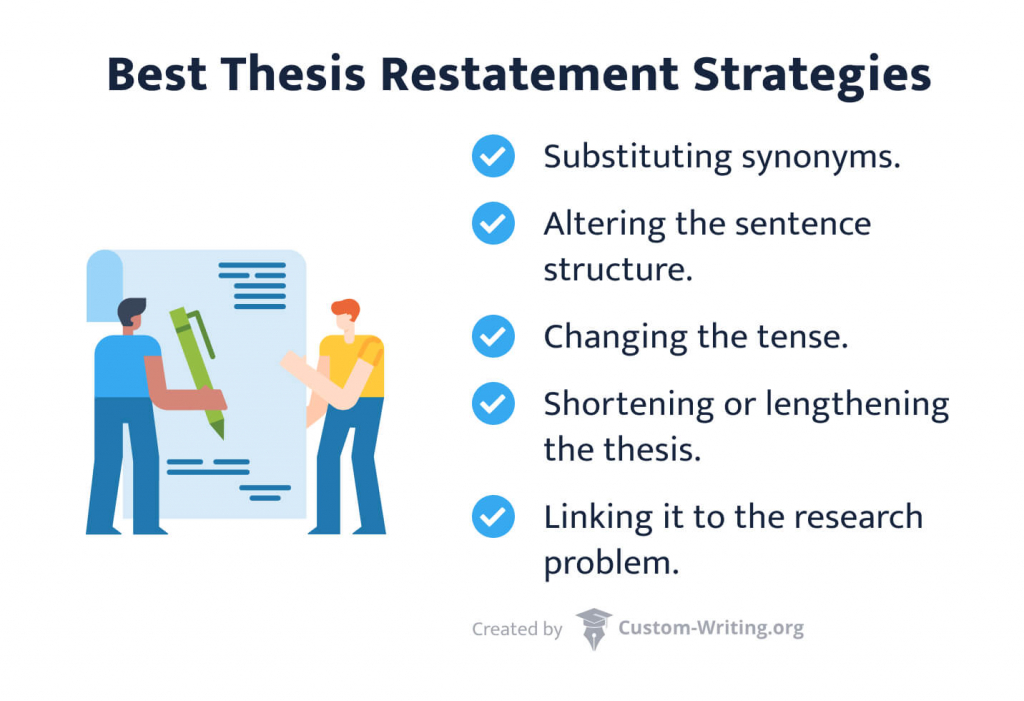The key to understanding how to restate a thesis is rephrasing the original statement in a way that keeps its core meaning and fits seamlessly into the context. A brilliant restated thesis reinforces your argument without redundancy and leaves a strong final impression on the reader.
Curious about how to restate your thesis statement effectively? Keep reading our writing guide! In this article, you’ll find:
- An explicit answer to the question, “What does it mean to restate a thesis?”
- Explanations of why rewriting your thesis is crucial to your paper
- Practical strategies on how to restate a thesis in conclusion—examples included
- Actionable tips to make your final message even more powerful
And if you ever get stuck, remember—our professional writing help is just a click away!
Restating a thesis is not all; you should also ensure it is consistently supported throughout the document and assists readers in navigating through your analysis and findings. Sounds overwhelming? Our team is ready to provide personalized guidance on any topic and turn your ideas into a polished, well-organized research paper. Let our affordable research paper writing service help you produce a high-quality paper with an effective thesis.
✍️ What Is a Restated Thesis?
A restated thesis is a reworded and restructured version of the original statement. It is presented in a conclusion or any other part of the essay requiring a recap of the paper’s main idea. It shouldn’t repeat the thesis statement word for word: instead, it’s better to focus on its content.
Why Restating Your Thesis Is Necessary
For a solid, effective academic work, a restated thesis in a conclusion is a must. Here’s why:
- A restated thesis helps reintroduce your central argument, thus enhancing its perceived significance.
- A correctly restated main claim makes the transition to the implications smoother.
- A paraphrased thesis restatement signals the readers about the wrap-up of your paper.
✅ How to Restate a Thesis Step by Step
Now, let’s dwell on the restatement process in more detail. We recommend you follow the steps we described below. It will help you make your paraphrased thesis effective without undermining your persuasive arguments.
💡 How to Rephrase a Thesis: Different Strategies
You can approach the restatement of thesis in several ways. Here are the best strategies that will make your argument effective and easily understood.

How to Restate a Claim by Substituting Synonyms
English is a language rich in synonyms, so you’ll hardly experience any trouble finding suitable substitutes for the words you’ve used in the original thesis. You can also try out an online reword generator or thesis statement maker to get different versions of your central claim.
For instance, imagine that this is your thesis:
Example:
People of color have achieved pronounced success in the fight for their civil rights and equality in the USA over the last century,
You may experiment with synonyms as freely as you want. Here are some variants:
Example:
- The 20-century civil rights movement gave many rights and freedoms to the minorities in the United States.
- The situation with racial equality improved significantly over the past 100 years, giving racial minorities a strong voice in American society.
Restating Your Thesis by Altering the Sentence Structure
The syntax is also a rich source of inspiration for thesis changes. If the original statement is compound, divide it into several shorter sentences. If you’ve used several simple sentences in the first version, consider combining them into one longer statement.
Here is an example of altering the thesis’ structure without changing the main points:
Example:
In the original version, we started by focusing on diabetes. In the reworded thesis, we presented the numbers as the first piece of data. This way, we’re directing the reader’s attention to the gravity of the problem.
How to Restate Your Thesis by Changing the Tense
In most cases, the original thesis statement uses future or present tense. It helps to inform the readers about what they are about to read. For instance, it can start with an introductory phrase:
Example:
I will argue that homework should be canceled to give students more free time and ease the burden of high school studies.
In this example, the thesis statement is written in the present tense. It links to the general statistics of time students spend on their homework. You can transform this statement into a past-tense sentence in the conclusion, showing that your argument has been proven.
Example:
The presented evidence showed that students benefited from homework cancellation and had more quality time for their hobbies and relaxation.
Restating a Thesis by Shortening or Lengthening It
The length of your thesis statement also matters. You may present it in a shorter way at the beginning of your paper, focusing only on the gist of your research question. Later on, once the arguments are laid out and explained in detail, you can present a more extended version of the initially formulated problem.
Example:
In this restates thesis example, we have extended the original idea, explaining what “assigned seating” and “school bullying” mean. This way, the reworded version could embrace the evidence discussed in the argumentative essay’s body.
Restating a Thesis by Linking It to the Research Problem
The strategy we’re about to describe is suitable for use in research paper writing. You will need to tie the thesis statement to the problem you’ve outlined in the introduction, linking it to the issue you’re examining.
For instance, in an essay on child obesity in the USA, you can restate the thesis as follows:
Example:
Although preventive healthcare has witnessed much advancement in the past decade, evidence proves that child obesity is still on the rise, with alarming annual increase rates.
📋 How to Restate a Thesis: Example Sentences
Now, let’s examine how to rephrase a sentence in practice. Have a look at these examples:
Example # 1
Here, we expanded the thesis statement by making it longer and adding some details.
Example #2
Here, we have changed the sentence structure by switching the first and second parts. The first example focuses on the legalization of marijuana, while the second version starts by mentioning the rising rates of teenage weed consumption.
Example #3
In this example, we’ve changed the thesis statement’s tense from future to past, showing how an intention transformed into a completed task.
🖼️ How to Reframe a Reworded Thesis?
Once you’ve approached the conclusion paragraph of your work, it’s time to think about reframing your main claim. It’s important not to duplicate the introductory thesis because its role in the final section is different. Here are some workable reframing suggestions:
- Reword the original thesis and put it at the beginning of your conclusion. It will bring the focus back to your initial research purpose.
- Enumerate the central claims you’ve focused on. They can be compiled from topic sentences used in the body paragraphs.
- After restating the thesis, you can dwell on the broader significance of the problem you’ve examined. Make a logically related call to action based on the cited evidence. You can also mention your study’s limitations and clarify what additional research is needed.
✨ Bonus Thesis Statement Tips
Now, it’s time to give you a bonus for careful reading: our tried-and-tested tips for good thesis rewriting. Check them out:
As you can see, rephrasing a thesis statement requires effort. Using extensive vocabulary and syntax will help you restructure the content and retain its meaning. And, of course, make sure to follow our tips!
Further reading:
- Best Thesis Statement Examples with Expert Comments
- How to Write a Conclusion for a Research Paper: Examples & Tips
- How to Write a 5-Paragraph Essay: Outline, Examples, & Writing Steps
- What Are the 5 Different Types of Essays? A Complete Guide
🔍 References
- Writing the Conclusion: Indiana University Bloomington
- Writing Introductory and Concluding Paragraphs: University of Minnesota
- How to Restate a Thesis Statement: Classroom: Synonym
- Writing a Paper: Conclusions: Walden University
- Conclusions: Purdue University
- Ending the Essay: Conclusions: Harvard University
- Thesis Statements: University of North Carolina at Chapel Hill




![Precis Example, Definition, & Writing Guide [2026]](https://custom-writing.org/blog/wp-content/uploads/2022/02/education-concept-student-studying-brainstorming-campus-concept-close-up-students-discussing-their-subject-books-textbooks-selective-focus-284x153.jpg)


![Critical Analysis Essay Example & Writing Guide [2026]](https://custom-writing.org/blog/wp-content/uploads/2021/10/business-men-sitting-lawyers-s-desk-people-signing-important-documents-284x153.jpg)



